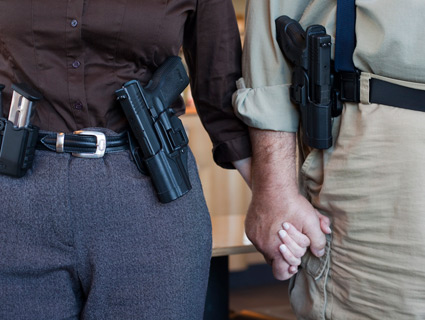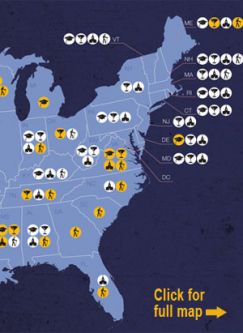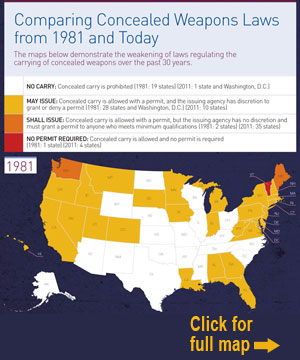
Gun owners at a local coffee shop in Fullerton, California.Steve Labadessa/ZUMApress.com
Ever thought about stashing a loaded Glock in your jacket and carrying it into a bar for a little extra protection? In Ohio, thanks to a new state law, you’re now free to do so. All you need is a permit.
Ever since Ohio implemented a “concealed carry” law in 2004—allowing the possession of a hidden, loaded handgun in public—changes in state legislation have made it increasingly easy for people to carry guns around. This year, Ohio lawmakers decriminalized having a concealed gun in a bar or restaurant that serves liquor, provided gun-toting patrons don’t drink any alcohol. Concealed guns are now allowed in bars, cars, public parks, and parking lots—and today, more than a quarter-million Ohioans have the permits needed to carry them there.
The changes in Ohio are part of a dramatic expansion of permissive gun laws across the United States. In just the past three years, 22 states have weakened or eliminated laws restricting the possession of concealed weapons, according to the Legal Community Against Violence, a public-interest law firm in San Francisco. These measures are easing eligibility and testing requirements for obtaining a permit, opening up public places to concealed weapons, and expanding legal protections for those who put their guns to use.
The impact of these changes could soon reach a whole new level. A federal concealed carry law now moving through Congress would require states to recognize each other’s permits, similar to the way in which driver’s licenses are valid across state lines. The National Right-to-Carry Reciprocity Act of 2011, which passed the House Judiciary Committee in late October, is scheduled for a floor vote in the House on Tuesday. If it goes on to pass in both chambers of Congress and is signed into law by the president (an outcome far from clear), the law would set up a race to the bottom for lax gun regulations. [Update: The bill passed in the House on November 16, 2011.]
Under the federal legislation, out-of-state permit holders would still have to obey individual state restrictions on where they could carry their concealed weapons. But the legislation would force states with strict permitting rules to recognize permits from states with weaker standards. For example, a state like New York—which allows police considerable discretion to deny concealed carry licenses even to persons without a serious criminal record—would have to welcome a concealed carry permit holder from Virginia, where people can obtain a permit online without ever having touched a firearm.
“Congress is simply ignoring the mayhem created by lax concealed handgun laws,” says Kristen Rand, legislative director of the Violence Policy Center, a Washington-based gun-control group. Since 2007, the group has identified 385 people—including 11 law enforcement officers—who have been killed in incidents involving private citizens allowed to carry concealed handguns. “And these incidents are only the tip of the iceberg since the gun lobby consistently blocks any attempt to collect comprehensive data on crimes committed by permit holders,” Rand says.
 From bars to parks, see a map of where concealed guns are now permitted near you. Source: Legal Community Against ViolenceRegardless of the fate of the federal legislation, the rollback of gun restrictions at the state level is continuing apace. In Wisconsin, for example, as of November 1 a concealed carry law allows weapons on parts of college campuses and in government buildings. In Louisiana, a law enacted in 2010 allows churches and other houses of worship to have armed security forces with concealed weapons. And since last year Arizona has allowed its citizens to carry concealed weapons without any permit at all.
From bars to parks, see a map of where concealed guns are now permitted near you. Source: Legal Community Against ViolenceRegardless of the fate of the federal legislation, the rollback of gun restrictions at the state level is continuing apace. In Wisconsin, for example, as of November 1 a concealed carry law allows weapons on parts of college campuses and in government buildings. In Louisiana, a law enacted in 2010 allows churches and other houses of worship to have armed security forces with concealed weapons. And since last year Arizona has allowed its citizens to carry concealed weapons without any permit at all.
The recent changes across many states reflect a shift in the strategy and tactics of the powerful gun lobby, including a growing emphasis on policy battles beyond the nation’s capital. Since 2003, the National Rifle Association has poured $2.3 million into the coffers of candidates for state offices, according to the non-partisan National Institute on Money in State Politics. Meanwhile, scores of grassroots groups with NRA ties have cropped up in recent years, making an impact with their political activism, militant tone, and aggressive tactics.
Recently these groups have been riding the momentum of Republican-controlled legislatures and celebrating what they see as a long-delayed recognition of their Second Amendment rights. They have updated their message, too: Recession-driven cutbacks in state and local law enforcement budgets have made it more important for ordinary citizens to pack heat. “Probably now more than ever,” says John Hohenwarter, the NRA lobbyist for Ohio, “people need the ability to defend themselves.”
A gun group’s aggressive tactics
When the Republican-controlled Ohio General Assembly convened in January, it took up legislation allowing permit holders to bring hidden loaded handguns into restaurants that serve alcohol. Since 2004, it has been legal in Ohio to bring a weapon into, say, a McDonald’s. The legislation to allow concealed weapons in establishments serving alcohol was opposed by the state’s restaurant and bartender associations, major law enforcement groups, and even by some Republican lawmakers. “We are not making it safer” by adding guns to the mix, said Republican Todd McKenney, who represents a district near Akron.
In addition to Irvine, who works as a commercial airline pilot, the leadership of the Buckeye Firearms Association includes Ken Hanson, a lawyer and NRA firearms instructor, and Chad Baus, a car dealer and the main blogger for the group’s website. The group’s weekly newsletter has more than 33,000 subscribers, and its website generates about 375,000 page views a month, according to Irvine. Features on the site include a messaging system for contacting legislators and a downloadable “Grassroots Action Guide,” with tips on activism and insights into “how the anti-gun mind works.” Periodic commentary under the title “The Idiot Chronicles” focuses on anti-gun lawmakers and other adversaries.
Buckeye also has its own PAC, and while its war chest is modest—about $54,000, according to Irvine—its giving is carefully targeted. Among the beneficiaries: the speaker of the Ohio House of Representatives, the secretary of state, the chair of the Ohio Republican Party, and the chief justice of the Ohio Supreme Court.
All this has made Buckeye a player closely watched by other groups. It is “a model that people are emulating and copying,” says Alan Gottlieb, founder of the Citizens Committee for the Right to Keep and Bear Arms, a national group that supports state and local gun activists, which named Buckeye its grassroots organization of the year in 2011.
The group’s political activism shows how the power of the gun lobby can cut across party lines. In 2010, Irvine campaigned for the incumbent governor, Democrat Ted Strickland (who ended up losing to Republican John Kasich). He rode around rural Ohio in a camouflaged RV dubbed “Sportsmen for Strickland.” The NRA gave $2,500 to Strickland and devoted an additional $26,000 in independent expenditures to his campaign, while Buckeye Firearms gave Strickland $1,000. Strickland, long a gun rights proponent, had earned the NRA’s highest candidate rating; Kasich has been considered suspect ever since he voted for a national assault-weapons ban as a member of Congress in the ’90s.
Irvine’s stumping for Strickland “ticked off a lot of my Republican friends,” he says. “People would ask, ‘Can we really trust a Democrat on the gun issue?’ My answer was, ‘I am a Republican. I am riding around with him. If that is the case, we can absolutely trust him.'”
[This story orgininally appeared online with the headline “Locked and Loaded for Happy Hour.”]
Buckeye Firearms has also targeted journalists it considers unfriendly to its agenda. Nobody knows this better than Matt Westerhold, the managing editor of the Sandusky Register, a 16,000-circulation daily in north central Ohio. For three years following passage of the 2004 concealed carry law, Westerhold says, he had been getting calls from readers wanting to know if their neighbors had guns. The law had made it permissible for journalists to access information about permit holders, but a local prosecutor had gone to court to stop another publication from publishing that information. Westerhold felt it was time to take a stand; he decided to publish the permit holder information “as a public service.” A list including the names and birth dates of some 2,500 permit holders appeared on the Sandusky Register‘s website.
For gun groups, it was a grave act of betrayal. The 2004 concealed carry law was never intended to allow for such wholesale publication of permit holder information, in their view. Rather, the idea was to allow journalists to determine whether specific individuals—someone with a criminal record, for instance—had a gun permit. But as they saw it the data dump gave gun thieves a road map, violated the privacy of permit holders, and discouraged citizens from getting permits.
 See how laws restricting concealed weapons have weakened over the last 30 years. Source: Legal Community Against Violence
See how laws restricting concealed weapons have weakened over the last 30 years. Source: Legal Community Against Violence
The reaction was fast and furious. “I was getting phone calls from all over the country, hundreds of phone calls,” Westerhold says. “There were so many nut jobs. There were so many threats: ‘I am going to kill you’ and ‘You should die slowly’.”
Then the Buckeye Firearms Association got involved, Westerhold says, “in a very pro-active way.” Using public records, the group posted on its website Westerhold’s auto records, a traffic citation, a partial Social Security number, an address for property he owned, and details about his divorce and ex-wife. It also included information on how one might find out which public school Westerhold’s 12-year-old daughter attended, which bus she took there, and how a photo of the girl from her school yearbook could probably be found in the local library.
“I never experienced anything like that in my life,” Westerhold says. He says he consulted an attorney and took the information to a local prosecutor, who found no grounds to take action.
Irvine says Buckeye Firearms did not publish the information about Westerhold to be vindictive, but rather to show the editor how easily a “bad guy” might get information on any one of the people on the list that the Sandusky Register had published. “We could have gotten way, way more personal,” Irvine says.
Do more guns lead to more violence?
Pro-gun groups’ argument in favor of permissive laws has always been that an armed citizenry means a safer community. The data, however, don’t corroborate that claim. A 2004 review of various studies by the National Research Council found “no credible evidence that the passage of right-to-carry laws decreases or increases violent crime.” In Ohio, violent crime actually increased for two years after the concealed carry law was adopted in 2004, an increase the law’s supporters say is due to other factors.
Still, at least four people with concealed carry permits have faced criminal charges for using their guns to kill people since the law went into effect. A Cincinnati woman with a permit shot and killed a panhandler in 2007 after he asked her for 25 cents at a gas station; she was sentenced to nine years. A man with a permit shot a Twinsburg, Ohio, police officer, who had pulled him over on suspicion of drunk driving; he was convicted of murder and sentenced to death.
Proponents of concealed carry permits argue that there are more examples of citizens using their guns to prevent crime or in self-defense. On its website, Buckeye Firearms cites the 2009 case of a 70-year-old great-grandmother who pulled a .357 Magnum from her purse and shot and killed an armed robber who had burst into her hotel room in Columbus.
But vigilante justice can be fraught with risk, particularly as it becomes possible in more places. Some restaurant and bar owners are struggling with how to implement the new law, worrying out loud about getting sued if they inadvertently serve someone who is packing. “Is there going to be a patdown? Do we have to ask every guest before we serve them a glass of wine?” asks Michael Singer, who manages the Barcelona Restaurant & Bar in Columbus. “Who carries the liability?” Since Ohio’s law went into effect on September 30, at least one Applebee’s has decided to exercise an option in the law that allows establishments to post a sign forbidding concealed weapons, in the hope of keeping armed people out.
But the momentum remains with the gun rights movement, especially as a growing number of Democrats are seeing little upside in voting against the gun lobby. If the National Right-to-Carry Reciprocity Act passes in the House of Representatives, it may well have key support in the Senate, too: Majority leader Harry Reid voted for a similar measure two years ago while running for reelection in Nevada.
Then, only a veto from President Obama would stand in the way—just as his own tough reelection fight really gets going.
This article first appeared under the headline “Locked and Loaded for Happy Hour.”
iWatch News is the website of the Center for Public Integrity, a Washington-based nonprofit organization dedicated to investigative journalism.







